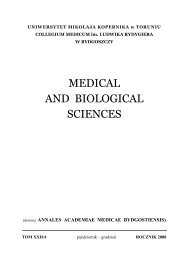Wsparcie spoÅeczne u chorych z miażdżycÄ tÄtnic koÅczyn dolnych
Wsparcie spoÅeczne u chorych z miażdżycÄ tÄtnic koÅczyn dolnych
Wsparcie spoÅeczne u chorych z miażdżycÄ tÄtnic koÅczyn dolnych
You also want an ePaper? Increase the reach of your titles
YUMPU automatically turns print PDFs into web optimized ePapers that Google loves.
14<br />
Paweł Sutkowy et al.<br />
better at higher concentration of oxygen than<br />
atmospheric – then the oxygen is toxic to them.<br />
Depending on exposure time and oxygen<br />
concentration, toxic effects range from being worse to<br />
diseases (neurodegenerative, autoimmune, infectious,<br />
cancerous) and permanent organs damage [1-3]. In the<br />
paper only physiological importance of oxygen<br />
derivatives in the human organism was presented.<br />
SOURCES OF REACTIVE OXYGEN SPECIES<br />
IN THE HUMAN ORGANISM<br />
Reactive oxygen species (ROS), including oxygen<br />
free radicals (OFR), can be formed in the human<br />
organism by an action of external physical factors such<br />
as ionizing and ultraviolet radiation, ultrasounds, as<br />
well as one of the mildest method of treatment of<br />
biological material – lyophilisation. ROS can be also<br />
produced as a result of an action of air ionizers, even<br />
though producers and dealers ensure that they have a<br />
positive effect on our health and ward off allergies [1].<br />
The oxygen is 7-8 times more soluble in organic<br />
solvents than in water. This property of oxygen is<br />
crucial for the human organism because physical<br />
properties of lipid layer of biological membrane are<br />
similar to properties of organic solvents. Therefore, the<br />
most important sources of ROS in the human organism<br />
are endogenous sources. There are many reactions<br />
during which intracellular ROS are generated: redox<br />
cycling of xenobiotics, respiratory proteins oxidation,<br />
reactions inside peroxisomes, oxidation of reduced<br />
forms of low-molecular cell components,<br />
photoreduction/photooxidation reactions and reactions<br />
of some specific enzymes. Nevertheless, a main source<br />
of ROS in the human organism is the respiratory<br />
electron transport chain [1, 4].<br />
CELLULAR RESPIRATION – THE ELECTRON<br />
TRANSPORT CHAIN (ETC)<br />
Aerobic respiration is based on a reduction of<br />
molecules of oxygen (O 2 ) to molecules of water,<br />
thereupon the energy is obtained:<br />
C 6 H 12 O 6 (glucose) + 6O 2 → 6CO 2 + 6H 2 O + 36ATP<br />
In fact, the molecular oxygen absorbed from the air<br />
is metabolised in the respiratory chain that is located at<br />
the inner membrane of mitochondria. Four electrons<br />
and four protons with cooperation of many enzymes<br />
and coenzymes are required to complete reducing by<br />
cell the oxygen to the water (fig. 1) [1].<br />
O 2 reduction may also be incomplete by premature<br />
electron leakage to the oxygen that occurs. Then, there<br />
is usually the one-electron reduction, thus being one of<br />
the main source of superoxide radical anion (O •− 2 ) – a<br />
harmful OFR that gives next ROS – fig. 1, 2. The<br />
oxygen reduction may also be two- or/and threeelectron,<br />
giving other reactive oxygen species as the<br />
end products – figure 1 [5].<br />
Fig. 1. Reduction of oxygen in the respiratory chain<br />
Ryc. 1. Redukcja tlenu w łańcuchu oddechowym<br />
Fig. 2. Superoxide radical anion as a source of other reactive<br />
oxygen species<br />
Ryc. 2. Anionorodnik ponadtlenkowy jako źródło innych<br />
reaktywnych form tlenu<br />
SELECTED EXAMPLES OF MOST IMPORTANT<br />
RADICALS<br />
The most abundant and important radicals in the<br />
human organism are those located on carbon, oxygen,<br />
sulfur, and nitrogen atoms. The carbon-centered<br />
radicals such alkyl (RC • HR’), hydroxyalkyl<br />
(RC • HOH), acyl (RC • =O), α-(alkylthio) alkyl<br />
(RSC • HR’) radicals are formed mostly due to hydrogen<br />
atom elimination from organic molecules. Especially<br />
significant among the oxygen-centered radicals are:<br />
hydroxyl ( • OH), peroxyl (ROO • ), alkoxyl (RO • ),<br />
phenoxyl (ArO • ), and semiquinone (HO-ArO • ) radicals<br />
and a superoxide radical anion (O 2 •− ). While the • OH is<br />
the most reactive among the O-centered radicals in<br />
biological systems, ROO • is probably the most

















